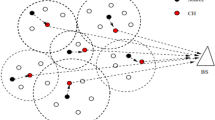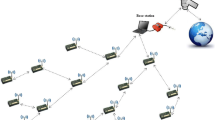Abstract
Simulation is an important tool to study and analyze sensor networks. Prior work in sensor network simulation focuses on homogeneous devices. In this paper, we present a system that performs scalable and accurate simulation of a network of heterogeneous sensor devices, including both Stargate intermediate level devices and mote devices. We study accuracy, performance, and scalability of our system. The results show that we can achieve accurate functional behavior for both standalone Stargate simulation and ensemble simulation of a Stargate and motes. For motes, we have less than 4.06% cycle count error for all benchmarks and for Stargate, we have less than 10% error for most benchmarks, and less than 12.5% error for all benchmarks. We also achieve less than 3.6% error for all benchmarks when simulating an ensemble of Stargate and motes. Our system is also more scalable than prior work. We can simulate 160 sensor nodes in real time speed and 2,048 sensor nodes with ten times slowdown on a 16-node cluster.
Similar content being viewed by others
References
R. Kumar, V. Tsiatsis and M.B. Srivastava. “Computation Hierarchy for In-network Processing,” in Proceedings of Second ACM International Workshop on Wireless Sensor Networks and Applications, September 2003.
L. Girod, V. Bychkovskiy, J. Elson and D. Estrin. “Locating Tiny Sensors in Time and Space: A Case Study,” in Proceedings of ICCD 2002, vol. 00, 2002, p. 214.
A. Farina, G. Golino, A. Capponi and C. Pilotto. “Surveillance by Means of a Random Sensor Network: A Heterogeneous Sensor Approach,” in Proceedings of IEEE 8th International Conference on Information Fusion, 2, 2005 (July).
A. Mainwaring, D. Culler, J. Polastre, R. Szewczyk and J. Anderson. Wireless Sensor Networks for Habitat Monitoring. ACM: New York, NY, USA, 2002, pp. 88–97.
Heterogeneous Sensor Networks at Intel Research. http://www.intel.com/research/exploratory/heterogeneous.htm.
Habitat Monitoring on Great Duck Island. http://www.greatduckisland.net/index.php.
Habitat Monitoring on James Reserve. http://www.jamesreserve.edu.
Ohio State University, Kansei: Sensor Testbed for At-Scale Experiments. Poster, 2nd International TinyOS Technology Exchange, Berkeley, February 2005.
Mirage: Microeconomic Resource Allocation for SensorNet Testbeds. https://mirage.berkeley.intel-research.net/.
G. Werner-Allen, P. Swieskowski and M. Welsh. “MoteLab: A Wireless Sensor Network Testbed,” Proceedings of the Fourth International Conference on Information Processing in Sensor Networks (IPSN’05), Special Track on Platform Tools and Design Methods for Network Embedded Sensors (SPOTS), 2005 (April).
P. Levis, N. Lee, M. Welsh and D. Culler. “TOSSIM: Accurate and Scalable Simulation of Entire TinyOS Applications,” in Proceedings of ACM Conference on Embedded Networked Sensor Systems, 2003 (November).
S. Park, A. Savvides and M.B. Srivastava. “SensorSim: A Simulation Framework For Sensor Networks.” Proceedings of the 3rd ACM international workshop on Modeling, analysis and simulation of wireless and mobile systems, 2000, pp. 104–111.
J. Polley, D. Blazakis, J. McGee, D. Rusk and J.S. Baras. “ATEMU: A Fine-Grained Sensor Network Simulator,” in Proceedings of First IEEE Communications Society Conference on Sensor and Ad Hoc Communications and Networks, 2004.
Simulavr: A simulator for the Atmel AVR family of microcontrollers. http://www.nongnu.org/simulavr.
S. Sundresh, W. Kim and G. Agha. “SENS: A Sensor, Environment and Network Simulator.” The IEEE 37th Annual Simulation Symposium, 2004.
B.L. Titzer, D.K. Lee and J. Palsberg. “Avrora: Scalable Sensor Network Simulation with Precise Timing.” The Fourth International Symposium on Information Processing in Sensor Networks, 2005 (April).
Mote hardware platform. http://www.tinyos.net/scoop/special/hardware.
Stargate: A Platform X Project. http://platformx.sourceforge.net/.
C. Pereira, J. Lau, B. Calder and R.K. Gupta. “Dynamic Phase Analysis for Cycle-Close Trace Generation,” in the Proceedings of the 3rd IEEE/ACM/IFIP International Conference on Hardware/Software Codesign and System Synthesis, CODES+ISSS 2005, 2005. Jersey City, NJ (September).
Intel XScale Microarchitecture XDB Simulator 2.0. http://www.intel.com/design/pca/prodbref/250424.htm.
D. Brooks, V. Tiwari and M. Martonosi. “Wattch: A Framework for Architectural-Level Power Analysis and Optimizations,” in Proceedings of the 27th annual international symposium on Computer architecture, 2000, pp. 83–94.
G. Contreras, M. Martonosi, J. Peng, R. Ju and G.-Y. Lueh. “XTREM: A Power Simulator for the Intel XScale Core,” in Proceedings of ACM SIGPLAN/SIGBED Conference on Languages, Compilers, and Tools for Embedded Systems, 2004 (June).
M. Rosenblum, S.A. Herrod, E. Witchel and A. Gupta. “Complete Computer System Simulation: The SimOS Approach.” IEEE Parallel and Distributed Technology, 1995, winter:34–43.
P. Magnusson and B. Werner. “Efficient Memory Simulation in SimICS,” in Proceedings of the 28th Annual Simulation Symposium, 1995.
P.S. Magnusson, F. Dahlgren, H. Grahn, M. Karlsson, F. Larsson, F. Lundholm, A. Moestedt, J. Nilsson, P. Stenstrm and B. Werner. “SimICS/sun4m: A Virtual Workstation,” in Proceedings of the 1998 USENIX Annual Technical Conference, 1998.
T. Austin, E. Larson and D. Ernst. “SimpleScalar: An Infrastructure for Computer System Modeling,” IEEE Computer, 2002.
P. Levis and D. Culler. “Mate: A Tiny Virtual Machine for Sensor Networks,”in ASPLOS-X: Proceedings of the 10th international conference on Architectural support for programming languages and operating systems, ACM: New York, NY, USA, 2002, pp. 85–95
Intel XScale Technology. http://www.intel.com/design/intelxscale/.
Familiar linux. http://familiar.handhelds.org.
J. Hill, R. Szewczyk, A. Woo, S. Hollar, D. Culler and K. Pister. “System Architecture Directions for Network Sensors,” in Proceedings of the 11th International Conference on Architectural Support for Programming Languages and Operating Systems, 2000 (October).
Intel StrataFlash Chip Verilog Model. http://www.intel.com/design/flcomp/toolbrfs/298189.htm.
F.A. Tobagi and L. Kleinrock. “Packet Switching In Radio Channels: Part II. The Hidden Terminal Problem In Carrier Sense Multiple-Access and the Busy-Tone Solution,” IEEE Transactions on Communications, COM, vol. 23, 1975, pp. 1417–1433.
Wireless Propagation Bibliography. http://w3.antd.nist.gov/wctg/manet/wirelesspropagation_bibliog.html.
A. Cerpa, J.L. Wong, L. Kuang, M. Potkonjak and D. Estrin. “Statistical Model of Lossy Links in Wireless Sensor Networks,” in the ACM/IEEE Fourth International Conference on Information Processing in Sensor Networks (IPSN’05), Los Angeles, California, 2005 (April).
G. Zhou, T. He, S. Krishnamurthy and J.A. Stankovic. “Impact of Radio Irregularity on Wireless Sensor Networks,” in Proceedings of the 2nd International Conference on Mobile Systems, Applications, and Services (MobiSYS’04), 2004.
J. Zhao and R. Govindan. “Understanding packet delivery performance in dense wireless sensor networks,” in Proceedings of the 1st international conference on Embedded networked sensor systems (SenSys’03), 2003.
O. Landsiedel, K. Wehrle and S. Götz. “Accurate Prediction of Power Consumption in Sensor Networks,” in Proceedings of The Second IEEE Workshop on Embedded Networked Sensors (EmNetS-II), Sydney, Australia, 2005 (May).
V. Shnayder, M. Hempstead, B. rong Chen, G. Werner-Allen and M. Welsh. “Simulating the Power Consumption of Large-Scale Sensor Network Applications,” in Proceedings of the Second ACM Conference on Embedded Networked Sensor Systems (SenSys’04), Baltimore, MD, 2004 (November).
V. Shnayder, M. Hempstead, B. rong Chen and M. Welsh. “PowerTOSSIM: Efficient Power Simulation for TinyOS Applications,” in Proceedings of the Second ACM Conference on Embedded Networked Sensor Systems (SenSys’04), Baltimore, MD, 2004 (November).
K.C. Syracuse and W. Clark. “A Statistical Approach to Domain Performance Modeling for Oxyhalide Primary Lithium Batteries,” in Proceedings of Annual Battery Conference on Applications and Advances, 1997 (January).
L. Benini, G. Castelli, A. Macii, E. Macii, M. Poncino and R. Scarsi. “A Discrete-time Battery Model for High-Level Power Estimation,” in Proceedings of Design, Automation and Test in Europe, 2000.
D. Rakhmatov and S. Vrudhula. “Time-to-Failure Estimation for Batteries in Portable Electronic Systems,” in Proceedings of the International Symposium on Low Power Electronics and Design, 2001 (August).
D. Linden and T. B. Reddy. Handbook of Batteries (3rd edition). McGraw-Hill, 2002.
Y. Wen, R. Wolski and G. Moore. “DiSenS: Scalable Distributed Sensor Network Simulation,” in Proceedings of ACM SIGPLAN Symposium on Principles and Practice of Parallel Programming, San Jose, CA, 2007 (March).
Chipcon CC1000 Brochure. http://www.chipcon.com/files/CC1000_Brochure.pdf.
K. Schloegel, G. Karypis and V. Kumar. “Graph Partitioning for High Performance Scientific Simulations,” Draft to be included in CRPC Parallel Computing Handbook, Morgan Kaufmann, 2000 (September).
H.D. Simon. “Partitioning of Unstructured Problems for Parallel Processing,” Computing Systems in Engineering, vol. 2, 1991, pp. 135–148.
A. Pothen. “Graph Partitioning Algorithms with Applications to Scientific Computing,” Parallel Numerical Algorithms, Kluwer, 1997, pp. 323–368.
B. Hendrickson and R. Leland. The Chaco User’s Guide: Version 2.0. Technical Report SAND94–2692, Sandia National Lab, 1994.
M.R. Guthaus, J.S. Ringenberg, D. Ernst, T.M. Austin, T. Mudge and R.B. Brown. “Mibench: A Free, Commercially Representative Embedded Benchmark Suite,” IEEE 4th Annual Workshop on Workload Characterization, Austin, TX, 2001 (December).
C. Lee, M. Potkonjak and W. Mangione-Smith. “Mediabench: A Tool for Evaluating and Synthesizing Multimedia and Communications Systems,” in International Symposium on Microarchitecture (Micro-30), 1997, pp. 330–335.
D. Niculescu and B. Nath. “Ad Hoc Positioning System (APS),” in Proceedings of IEEE Global Communications Conference, 2001 (November).
G.W. Hill. “ACM Algorithm 395: Student’s T-Distribution.” Communications of the ACM, vol. 13, no. 10, 1970, pp. 617–619 (October).
SimpleScalar for ARM. http://www.simplescalar.com/v4test.html.
D. Watson and M. Nesterenko. “Mule: Hybrid Simulator for Testing and Debugging Wireless Sensor Networks,” in Workshop on Sensor and Actor Network Protocols and Applications, 2004 (August).
L. Girod, T. Stathopoulos, N. Ramanathan, J. Elson, D. Estrin, E. Osterweil and T. Schoellhammer. “A System for Simulation, Emulation, and Deployment of Heterogeneous Sensor Networks,” in Proceedings of ACM Conference on Embedded Networked Sensor Systems, 2004 (November).
L. Girod, J. Elson, A. Cerpa, T. Stathopoulos, N. Ramanathan and D. Estrin. “EmStar: A Software Environment for Developing and Deploying Wireless Sensor Networks,” in Proceedings of USENIX Tech. Conf., 2004.
R.F. Cmelik and D. Keppel. “Shade: A Fast Instruction Set Simulator for Execution Profiling,” in Proceedings of ACM SIGMETRICS, 1994.
E. Witchel and M. Rosenblum. “Embra: Fast and Flexible Machine Simulation,” ACM SIGMETRICS Performance Evaluation Review, vol. 24, no. 1, 1996, pp. 68–79 (May).
SimOS-PPC: ARL’s Full System Simulation Project. http://www.cs.utexas.edu/users/cart/simOS/index.html.
R.C. Bedichek. “Efficient Memory Simulation in SimICS,” in Proceedings of ACM SIGMETRICS, 1995.
SKYEYE: An Embedded Simulation System. http://www.skyeye.org.
QEMU: A Generic and Open Source Processor Emulator. http://fabrice.bellard.free.fr/qemu/.
The Bochs IA-32 Emulator Project. http://bochs.sourceforge.net.
PearPC: PowerPC Architecture Emulator. http://pearpc.sourceforge.net/.
Author information
Authors and Affiliations
Corresponding author
Rights and permissions
About this article
Cite this article
Wen, Y., Gurun, S., Chohan, N. et al. Accurate and Scalable Simulation of Network of Heterogeneous Sensor Devices. J Sign Process Syst Sign Image 50, 115–136 (2008). https://doi.org/10.1007/s11265-007-0113-2
Received:
Revised:
Accepted:
Published:
Issue Date:
DOI: https://doi.org/10.1007/s11265-007-0113-2




